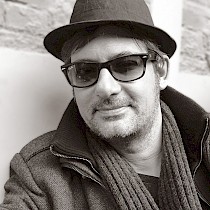Prof. Benjamin Seide

Benjamin Seide, Forscher und Medienkünstler, lebt in Singapur und Berlin und arbeitet im Bereich Animation und Immersive Medien. In den 90er Jahren drehte Seide seinen ersten interaktiven 360˚ Film mit einer selbst entwickelten Kamera und beschäftigte sich in seiner Arbeit "Paramatrix" mit der Erforschung von Repräsentation im virtuellen Raum. Seine Arbeit als Visual Effects Artist aus den 2000er Jahren ist in Art House- und Hollywood-Filmen zu sehen, darunter Wim Wenders "Don't Come Knocking", Roman Polanskis "Oliver Twist" und Martin Scorseseses "Hugo". 2009 - 2013 lebte und arbeitete Seide in Shanghai und kreierte das preisgekrönte immersive Erlebnis des General Motors World Expo Pavillons. Derzeit konzentrieren sich seine Projekte auf die künstlerische Interpretation des Kultur- und Filmerbes in Immersiven Medien, darunter die Dome-Installation "Homage á Fellini", der 360˚ Film "Secret Detours" und die VR-Installation "Gone Garden", beides Interpretationen des chinesischen "Yunnan" Gartens in Singapur, und "The Spirit of Pontianak", eine VR-Installation des verlorenen Horrorfilms "Pontianak" von 1958.
www.ataribaby.de
bseide@ntu.edu.sg
Synopsis
Be the centre of the universe – strategies and concepts to experience immersive media.
The 360° video »Secret Detours« served as an immediate approach to digitally preserve a Chinese garden in Singapore. Currently, my collaborators Benjamin Seide, Ross Wiliams and myself have developed a range of different versions in order to explore the screening possibilities and have adjusted both, the visual composition and the sound design accordingly.
»Secret Detours« was captured in a Chinese garden in Singapore, which opened in 1956 – quite old for the 53-year-old city-state. The garden is undergoing massive redevelopment, several old trees have been cut down, bridges and pavilions have been removed. Since it was important to act quickly, the garden was filmed as a spherical 360° video, not only for artistic but also for conservation purposes. Four dancers acted out a choreography by Susan Sentler to represent the cardinal directions of Chinese mythology, after which the garden was initially conceived. Although the visualisation gives an impression of being inside the garden, it is still a very static experience. Therefore we are currently working on a room scale model for VR that makes the garden accessible in virtual space, based on the floor plan and the photogrammetric recording of details.
Considering the respective iterations, the perception of the work and with it the experience differs hugely, depending on the particular presentation technique: whether the work is collectively viewed in a hemispherical dome, a cylindrical panorama, on a panoramic video wall, or with a range of different VR headsets.
As the technology of spherical recording and presentation is still very much in flux, due to the rapid developments and along with peculiar improvements by the industry. There are a number of aspects to further explore, in particular the connection of virtual representations in the real environment through mixed reality.
Alle Sprecher
- Yasser Almaamoun
- Thorsten Bauer
- Sergey Biniaminov
- Christopher Coenen
- Prof. Ina Conradi
- Prof. Dr.-Ing. Barbara Deml
- Hon. Prof. Joséphine Derobe
- Florian Dohmann
- Felix Gaedtke
- Diego González-Zúñiga
- Prof. Lisa Gotto
- Dr. Lily Hibberd
- Prof. Johan Frederik Hartle
- Dr. Rocio von Jungenfeld
- Sönke Kirchhof
- Mario Klingemann
- Dr. Elias Knubben
- Dr. Sebastian Knorr
- Prof. Verena Kraemer
- Prof. Susanne Kriemann
- Dr. Barbara Kuon
- Prof. Frederic Fol Leymarie
- Roman Lipski
- Anja-Maria Meister
- Prof. Galina Mihaleva
- Prof. Dr. Eduardo R. Miranda
- Lauren Moffatt
- Prof. Julian Oliver
- Prof. Dr. Dr.-Ing. Jivka Ovtcharova
- Gülsel Özkan
- Prof. Matteo Pasquinelli
- Prof. Vesna Petresin
- Prof. Dr. Mark Post
- Oliver Rack
- Prof. Elke Reinhuber
- Prof. Christiane Riedel
- Dr. Ralf Schäfer
- Prof. Benjamin Seide
- Dr. Markus Schmidt
- Kathleen Schröter
- Prof. Aljoscha Smolic
- Prof. Vibeke Sorensen
- Prof. João Tabarra
- Cyril Tuschi
- Holger Volland
- Dr. Lioudmila Voropai
- Yulu Wang
Kontakt
Interesse? Fragen?
Rufen Sie uns an:
+49 (0)721 / 8100 6001
oder schreiben Sie uns:
info@beyondfestival.com




